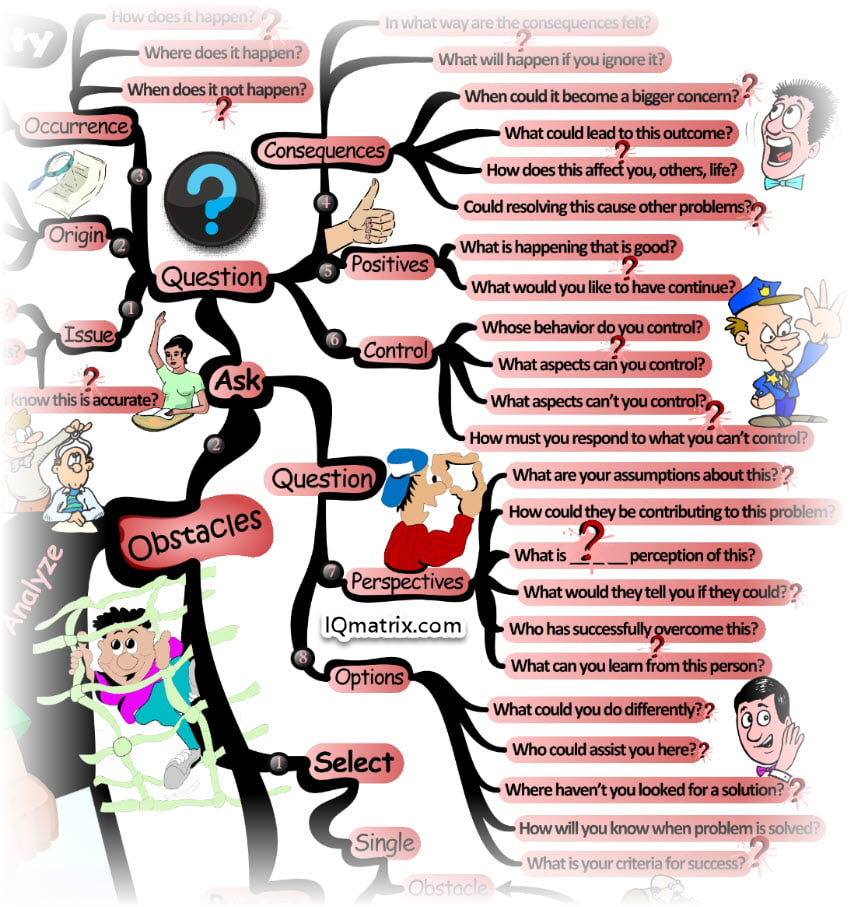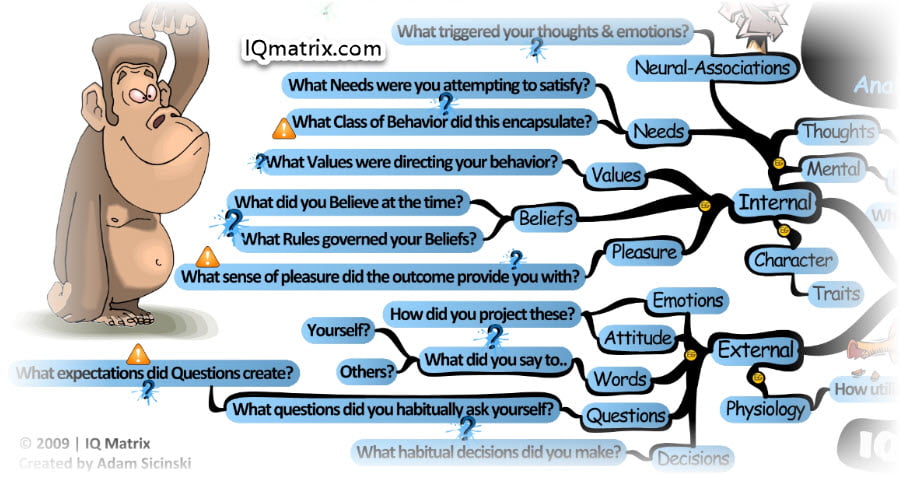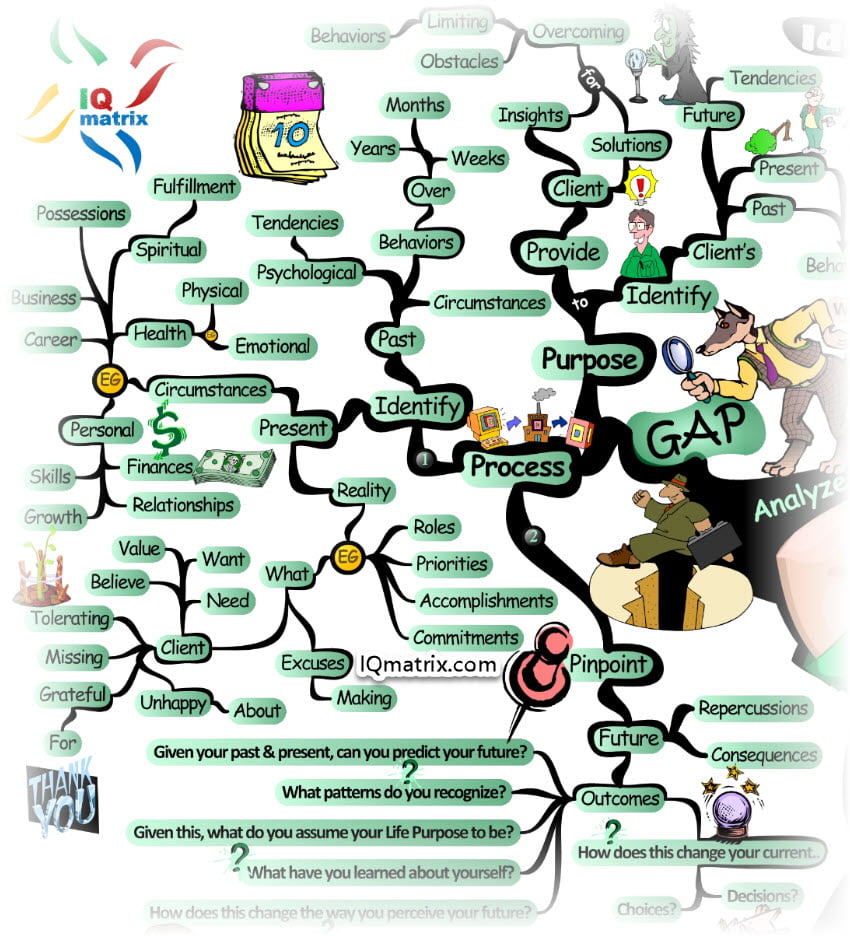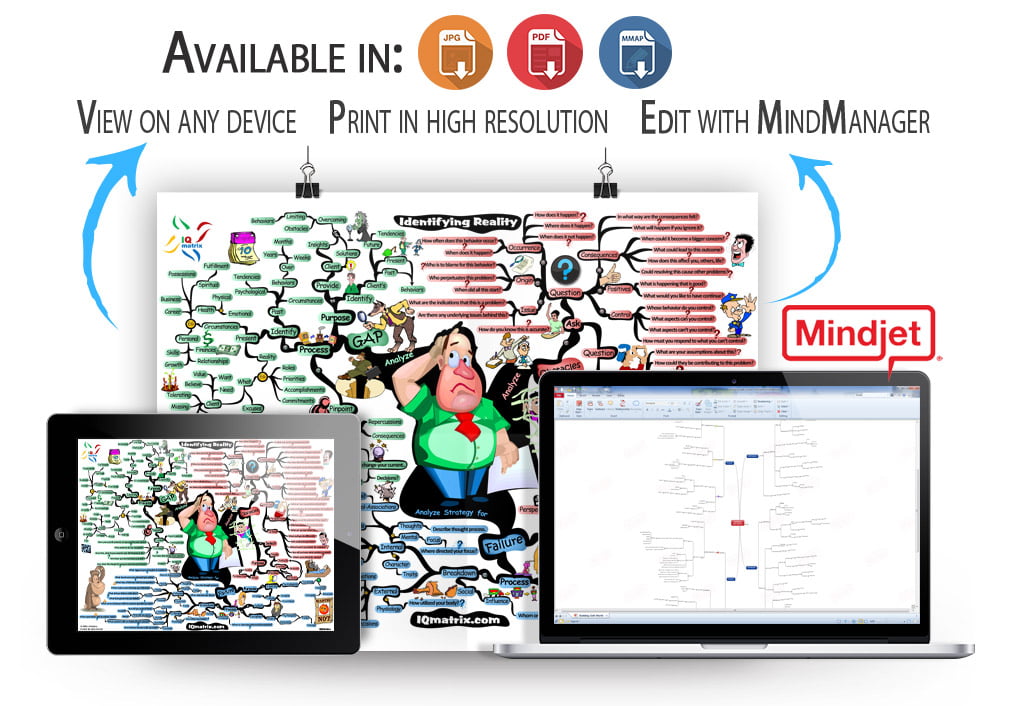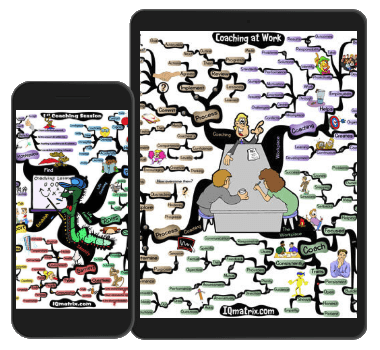Success and failure are both greatly overrated. But failure gives you a whole lot more to talk about. – Hildegard Knef
This is the third of a four-part series of articles that walks you through the first couple of life coaching sessions with a client. All articles within this series include:
- The First Life Coaching Session
- Addressing Your Client’s Concerns
- Current Reality Identification
- Current Reality Evaluation
Analyzing Your Client’s Challenges
One of the main reasons a client might come to you for coaching is because they are seeking some guidance to help them overcome a number of obstacles that are probably preventing them from attaining their goals and objectives. These obstacles can, of course, come in many forms. They can, for instance, be environmental, social, circumstantial, physical or emotional obstacles. The type of obstacle that your client faces isn’t important. What’s important is that as a coach you are successfully able to break down the psychological walls and the negative impact that this obstacle has on your client’s life, because it’s after all not what we face that matters, but rather how we face things that makes all the difference in the end.
Your main objective as a coach is to empower your client through effective questioning techniques that will help change their behavior and alter their perspective on reality. Once your client’s perspective shifts, they will begin to view their life and circumstances in a very different way, and this will subsequently help alter the decisions they make and actions they take in relation to this obstacle. Your client will essentially become empowered, more resourceful and therefore able to take the necessary steps forward to overcome their problems successfully.
The Obstacle Analysis Process
To begin this process, ask your client to think of a single obstacle or a limiting behavior that they feel is preventing them from moving forward. Remember that obstacles can come in many forms. It, therefore, doesn’t really matter what obstacles your client brings to mind. The questions you are about to ask can be modified to fit just about any kind of obstacle your client might face.
Once you have gained some clarity about this obstacle, it’s now time to question the issue at hand. Ask your client:
What are the indications that this is a problem?
Are there any underlying issues behind this problem?
How do you know all this is accurate?
Your main objective with these questions is to clarify whether or not this is actually a problem. Sometimes what seems like a problem isn’t a problem at all. Things only seem problematic because we approach them with an unresourceful mindset, which limits our ability to see things clearly. But if an actual problem does exist, it’s still important not to settle on the fact that this is the real problem, because there could very well be many underlying issues that are creating this surface problem. Therefore, if you only tackle the surface problem and don’t successfully handle the underlying issues, then you’re only essentially applying a band-aid to the wound. Yes, this might help heal the wound, however, the cause of the wound may still become an issue at a later time. As such, it’s important to work through the “cause” rather than the “hurt” that the cause has manifested.
Let’s now shift focus and take a look at the origins of this problem. Ask your client:
Who is to blame for this problem/behavior?
Who perpetuates this problem?
When did all this start?
Before your client can move forward in any way, they must take full responsibility for this problem. This means that they need to let go of complaining, making excuses or blaming external people, events and/or circumstances for the problem. It, therefore, does not really matter how the problem originated or how it is maintained — at least not at this stage. All that matters is that your client becomes aware of where their responsibility lies in relation to this problem. It’s only when they take full responsibility for things, will they then be able to work through this problem successfully.
One of the keys to overcoming any kind of problem comes down to pattern recognition. Every problem you face exists because of a set of patterns that perpetuate the problem. These patterns might, for instance, be specific kinds of behaviors, decisions, circumstances, etc. Exploring these areas in a little detail will no doubt help you gain deeper insights into the intricate “workings” of this problem. Ask your client:
How often does this behavior/problem occur?
When exactly does this happen?
How exactly does this happen?
Where exactly does this happen?
When does it not happen?
Why does it not happen during these times?
Does anything change during these times?
Are you doing anything differently?
The key area of focus here is to search for exception times. These are times when the problem your client is facing does not occur for one reason or another. Within these exception, times is where you might be able to find the answers you need to help your client overcome their problem successfully. In fact, your client might not even be aware of these exception times up until the moment you bring them to conscious awareness. And ironically this awareness might be all they need to gain the necessary insights required to help them work through their problem effectively.
Your next task is to take a look at the consequences of this problem and how it is affecting your client’s life. Ask your client:
In what way are the consequences of this problem felt?
What could potentially happen if you do nothing about this and just ignore the problem?
When might this problem become an even bigger concern in your life?
What could potentially lead to this negative outcome?
How would this potentially affect you, others and your life?
Could resolving this problem potentially cause other problems for you? Why? Why not?
Here you are attempting to use pain as a motivating force to help convince your client that they need to begin taking the necessary steps to overcome their problem successfully; otherwise negative consequences might befall them.
Whatever problem your client might be facing, it’s important to recognize that often things are not all bad. There might, in fact, be some things that are good that your client would like to keep as part of their life, whether the problem exists or not. Ask your client:
What is happening that is good?
What would you like to have continue to happen?
If it’s a behavior that you are dealing with, then there might actually be some aspects of this behavior that are very helpful and advantageous. It’s important you recognize this as a coach and encourage your client to find ways to keep these positive aspects intact as you work towards an adequate solution to their problem.
At times the problems we face are simply out of our control. Yes, we can certainly control how we think and feel, however, there might be other things that are beyond our influence. And yet, as human beings we seek a sense of certainty, and we, therefore, want to be able to control everything; and when we’re not able to control everything we feel miserable and defeated. This in itself can cause additional problem that can prevent us from moving forward successfully. As such, it’s important to clarify where the “control” lies in relation to your client’s problem. Ask your client:
What aspects of this problem can you control?
What aspects of this problem can’t you control?
Whose behavior do you control?
How must you respond to the things that you can’t control?
If there are aspects of this problem that are simply out of your client’s personal control, then it’s important that they accept these things without resistance. They must accept the fact that some things are never going to be within their control, and as such must make the best use of what they can control to help improve their behavior, life, and circumstances.
It’s now time to begin shifting your client’s perspective about their problem. Ask your client:
Are there any possible assumptions you might be making about this problem?
How could these assumptions be contributing to this problem?
What is [person’s name] perception of this problem?
What specifically would they tell you if they could?
Who has successfully overcome this problem before?
What can you learn from how this person overcame this problem?
These set of questions are designed to help your client shift how they begin to think about their problem. It’s however important that you don’t just stick with these questions. Spend time asking your client additional questions that force them to step into the shoes of cartoon characters, famous people, inanimate objects, etc. You might, for instance, ask your client how Bugs Bunny, Albert Einstein or Harry Potter would perceive this problem. That in itself might provide your client with the perspective-shift they need to see their problem, life and circumstances in an empowering new way.
The final set of questions in this process involve exploring options that might help resolve this problem. Ask your client:
What could you now do differently to resolve this problem?
Who might be able to assist you with resolving this problem?
Where haven’t you looked for a solution as yet?
How will you know when this problem has been successfully resolved?
What is your criteria for success?
Your objective with these questions is to lead your client down a path where they are more resourceful, optimistic and open-minded about working through this problem successfully. In fact, at this stage, your client should now have the necessary insight and confidence they need to begin taking the necessary steps to work through their problem effectively. However, there is, of course, a chance that they might not succeed because they are so caught up in their old patterns of behavior that their likelihood of success is slim at best. And for this very reason, you will need to spend some time exploring your client’s failure strategy.
Analyzing Your Client’s Failure Strategy
All of us do certain things very well and other things not so well. At times what we do works well for us, while at other times we fail miserably and wonder why we even bothered trying in the first place.
If we relate things back to your client’s problem, then you will typically find that your client does things a certain way that continuously perpetuates this problem. In other words, they have a “failure strategy” where they continue to “mess things up” persistently because of a set of internal and external patterns of behavior that they consistently indulge in.
Your task here is to identify your client’s failure strategy in relation to the problem that they are facing. This essentially comes down to pinpointing recognizable psychological tendencies that your client indulges in that prevent them from moving forward. In other words, these are consistent things that they do that always get them the same miserable results time and again.
Imagine for a moment that you are learning how to ski. Obviously, in the beginning, you will make plenty of mistakes and fall flat on your face over and over again. You fall over this many times because you don’t quite have the technique right or the confidence and the self-belief you need to be able to ski down a slope in an upright position.
Over time you, of course, get better and better and are able to stand on your feet for longer periods at a time. You’ve improved because you’ve learned from the mistakes you made. In other words, you’ve learned from what you failed to do before and subsequently made the necessary adjustments to improve your results. And yet, little do you realize that this learning curve only came about because you were willing to make the necessary adjustments to improve your skiing technique. You didn’t just settle on doing the same thing over and over again. You instead made alterations to how you moved your body and how you thought about the situation. And as a result, you got better and have now become a very proficient skier.
This kind of scenario is very typical when it comes to learning how to ski. We start off feeling uncertain and make plenty of mistakes, however over time we get better because we are willing to adjust our technique and adapt to the situation. However, what if you never adjusted your technique and continued to do things the same way you did them the very first time you put on those skis? Would you improve? No, of course, you wouldn’t. You wouldn’t improve because you’re doing and thinking about things the same way. Improvement only comes when you do and think about things differently.
If we now apply this example to real-world problems, you will find that the problems you consistently fail to overcome come with a “beginner’s mentality”. And as we know, beginner’s don’t get very far and certainly don’t have a high rate of success. In fact, more often then not they fail because they don’t have the necessary experience to know any better. As such, what they do, becomes their “failure strategy”, which essentially comes down to doing all the wrong things that will ensure you don’t get your desired outcome.
Have you ever wondered how some people keep repeating the same mistakes over and over again and end up getting nowhere? They end up getting nowhere because they keep applying the same strategy every single time, and unfortunately for them, it’s the wrong strategy that leads to failure. What’s worse, is that they don’t consciously recognize this, and as a result, they use more or less the same strategy in other areas of their life and end up experiencing the same miserable results.
People use the same “failure strategy” over and over again, not because it makes them feel good, but rather because it feels comfortable and familiar. Whether it works or not is irrelevant. What’s most important is that it creates a sense of certainty, and allows the person a sense of control over their behavior.
We all, in fact, have strategies we use that lead to failure, as well as strategies we use that lead to success. We can, in fact, apply both strategies to a variety of situations, but unfortunately, we are rarely consciously aware of them and therefore fail to activate them in our lives. If only we knew what these strategies were. Just maybe then we might be able to apply what worked in one situation into another situation and get the same results. Wouldn’t that be incredible?
For the purpose of this discussion, let’s look at exploring a client’s failure strategy. These are the things that they consistently do that lead to failure and stagnation when tackling a specific problem or issue. Let’s specifically break this failure strategy into three types of factors: internal, external and social.
Internal Factors
Internal factors are related to the inner workings of our psyche. These are the things that normally sit just below the surface of conscious awareness — tending to influence us in very specific ways. For instance, your thoughts, mental focus, human needs, values, beliefs and how you respond to pain and pleasure are all factors that provide the ingredients for a failure strategy.
Ask your client to think of a time they failed miserably while working through their problem. As your client talks about their experience, be sure to ask them some of the following questions:
Can you describe what you were thinking at the time?
Did anything specifically trigger these thoughts?
What were you feeling at the time?
Why were you feeling this way?
How were you thinking about these things?
What were you focusing on?
Why were you focusing on these things in this way?
Were there any particular human needs you were attempting to satisfy at the time?
What class of behavior did this encapsulate?
What specific values were directing your behavior?
What did you believe at the time?
What did you believe about yourself, others and circumstances?
What expectations did you have?
What psychological rules governed your expectations?
Did you derive any sense of pleasure from this outcome?
As you go through this analysis process, keep asking your client deep questions that help unlock aspects of their psyche. Your objective is to identify patterns about how your client thought about things, what they believed at the time, how they focused on their circumstances, etc. All these factors will help you figure out why they failed. We must after all first understand what didn’t work before we can make the necessary adjustments to improve the strategy.
For insights about the four classes of behavior and the influence of the six human needs, please read Exploring the Six Human Needs.
External Factors
Within the context of this discussion, external factors are things that we project out into the outside world. These things might include emotions, attitudes, words, questions, and decisions.
Here are some questions you can ask your client that will help you to gain some clarity about the external factors involved in your client’s failure strategy:
What emotions did you experience at the time?
How did you project your emotions?
What was your attitude like?
How did you project this attitude?
How did you use your body at the time?
Did you use your physiology in optimal ways or was it kind of flat?
What specifically did you say to yourself?
What did you say to others at the time?
Are there any questions you habitually asked yourself?
What expectations did these questions create?
What decisions did you make at the time?
What specific actions did you take?
What was the outcome of these decisions and actions?
Again, as you work through these questions it’s important to get a deep understanding of the patterns that are coming to the forefront. Your client will have done things a certain way that essentially led to their failed attempt; thereby creating their failure strategy. And these are the typical patterns that you must note down in order to decipher the nature of this strategy.
Social Factors
The final area that you might want to look at are social factors. Your client’s choices, decisions, behavior, and actions might very well have been influenced by other people within their social circle. It’s after all very possible that without these influential forces that they might have experienced a different outcome. Ask your client:
Have a think about everything you did or chose not to do? Were these choices and decisions in your hands?
Were you influenced by other people in any way? Who influenced you?
How specifically were you influenced by these people?
How would you have done things if you weren’t influenced by these people?
Peer influence can often be a big factor when it comes to the typical choices and decisions we tend to make in critical situations. As such, it’s important to bring these influences to light while piecing together your client’s failure strategy.
For information about helping your client overcome social influence, please read How to Overcome Peer Influence.
Now that you have all these questions answered, it’s time to bring to mind other problems and issues your client has failed to overcome in the past in an attempt to get a sense of whether or not they used a similar “failure strategy”.
While bringing to mind other failed attempts, you might, of course, gain further insights into your client’s strategy that you can use to unlock deeper psychological patterns of behavior. Then, of course, it’s up to you to use these insights to help convince your client that applying this “failure strategy” over and over again will be to no avail. If your client wants to transform their results, then they must begin by altering the strategy they use while working through their problems. Without any alterations, nothing will change, and they will continue to experience the same lousy results in their lifetime after time.
Your client does, of course, have a “success strategy” that they might not be consciously aware of. They can essentially use this strategy to help transform their results in any situation. And it’s of course up to you as a coach to help them unlock the psychological patterns associated with this strategy. However, we’ll discuss this in more detail within part four of this life coaching series.
Analyzing the GAP
The GAP is the place between your client’s current reality and their desired reality. Within this GAP lie an endless array of possibilities and opportunities that can potentially be taken advantage of. However, what your client probably doesn’t realize is that their desired reality is never going to come to fruition if they don’t start making the necessary changes to their current reality.
The GAP analysis process helps you unlock patterns within your client’s past and present behavior in order to help you more accurately predict their future tendencies. This by itself might provide your client with the “wakeup call” they need to begin making some rapid changes to their life in the present moment. If nothing more, this process will help your client gain the necessary insights they need to potentially overcome any limiting behaviors that are preventing them from moving forward in a more positive way.
Past Analysis
Your first objective is to delve into your client’s past history. Here you would ask your client general questions about how their life was 1 to 10 years ago. Pay particular attention to your client’s:
- Hopes, dreams and aspirations and how they have changed over the years.
- Habitual patterns of behavior.
- Ability to manage change and life transition periods.
- Peer influences and how they shaped their choices, decisions, behaviors, and actions.
- Life circumstances including relationships, career prospects, and anything else that may be related to their current situation.
- Emotional tendencies and in particular how they coped with their emotions in the past.
- Resourcefulness and how they overcame particular problems or failed to overcome these problems.
- Values and how they have changed over the years.
- Belief systems and how they have directed their decisions and actions.
What you’re attempting to do here is build a picture of your client’s life over a period of about five to ten years. This time period might provide you with the “golden nuggets” you need that will help you guide your client through current challenges that are preventing them from moving forward. Moreover, this analysis will provide you with valuable insights into your client’s patterns of behavior that might now be preventing them from overcoming their current problems.
All this comes down to pattern recognition. It basically comes down to your ability as a coach to spot patterns and psychological tendencies that direct your client’s life and circumstances. Your client might very well want to be in a very different place then they are at this very moment. However, if over a period of 5 or 10 years nothing has changed, then there are very concrete reasons why things haven’t changed; and it’s your goal to bring these reasons to the surface.
Present Moment Analysis
Next, you would move to the present moment and analyze what your client’s life is like today. Here you would naturally ask similar kinds of questions as you did during the Past Analysis stage, however, you would also go into more detail in order to get a better understanding of the psychological tendencies your client is bringing into every situation. In particular, try and guide the conversation onto the following key topic areas:
- Gain some insight into your client’s career path and whether or not they are where they desire to be.
- Ask your client about their level of fulfillment in terms of their health, relationships, finances, growth, career, etc.
- Get a sense of your client’s roles, priorities, responsibilities, and commitments.
- Pinpoint the things that your client is currently working towards. You might very well find that they have conflicting goals.
As you listen to your client’s story, pay attention to the excuses that they might be making; to the things that make them happy and unhappy; to the things they are grateful for and to the things they are tolerating; to what is missing in their life; to what they value most in life; to what they want, need and seek to create in their life, etc. It’s important to take the time to note down all these things because they will provide you with the necessary insights you need to help guide your client in the right direction moving forward.
It’s also important to pay attention to the things that your client had previously wanted to change. Maybe they were successful, or maybe they weren’t successful at changing these things. It’s critical to note this down because if your client hasn’t changed over the years, then they cannot realistically expect that their life will be any different several years into the future. Unless they change who they are (their habitual patterns of behavior) then they will always have what they’ve had and nothing more. That’s unfortunately, unfortunately,f life, and it’s, of course, important that you make them aware of this fact.
Future Time Predictions
Finally, take your client on a journey into the future. Ask them to take into account everything they did in the past as well as their current life and circumstances. Now move several years into your client’s future and ask them:
Given your past and present circumstances, can you predict your future?
Do you recognize any significant patterns in your behavior over the past 5 to 10 years?
How have these patterns shaped your life to date?
What will your future be like in 12 months time if you continue indulging in these patterns?
What about in 5 years time? How will your life be different if you keep repeating these patterns? Will it be any different?
If you could sum up these patterns in one sentence, what would you assume your life purpose to be?
Do you want this to be your life’s purpose? Or do you want to choose something else?
This analysis is all about getting a clear understanding of the consequences that may result if your client continues doing what they’ve always done. And this can, of course, be very difficult to accept. It’s not easy to accept the fact that your desired life might not come to fruition. And it’s certainly very difficult to accept that your life’s purpose is to live a very mediocre and stressful existence. But that is the reality that most people live with. They of course hope and dream of this marvelous purpose they have for this lifetime, but those dreams are only wishes that will unfortunately never materialize unless they take personal responsibility for their own lives and begin making some small changes that will help move them in a better direction.
The final set of questions you might like to ask your client focus on exploring what they might have gained from this process. Ask your client:
What have you learned about yourself going through this process?
How does this analysis change how you perceive your future?
Does this change the choices and decisions you will now make from this day moving forward? How?
This entire process is designed to provide your client with a rude “wakeup call”. They might very well have slept through the past 10 years of their life, however, it’s now time to get out of bed and start taking action in a more positive direction. Without this action and without a necessary shift in perspective, they will, unfortunately, continue to live the life they’ve always lived while experiencing the same problems they’ve always experienced, and nothing will ever change. Is that really the kind of life you want for your client? Is it really the kind of life you want for yourself?
Time to Assimilate these Concepts
Did you gain value from this article? Is it important that you know and understand this topic? Would you like to optimize how you think about this topic? Would you like a method for applying these ideas to your life?
If you answered yes to any of these questions, then I’m confident you will gain tremendous value from using the accompanying IQ Matrix for coaching or self-coaching purposes. This mind map provides you with a quick visual overview of the article you just read. The branches, interlinking ideas, and images model how the brain thinks and processes information. It’s kind of like implanting a thought into your brain – an upgrade of sorts that optimizes how you think about these concepts and ideas. 🙂
Recommended IQ Matrix Bundles
If you’re intrigued by the idea of using mind maps for self-improvement then I would like to invite you to become an IQ Matrix Member.
If you’re new to mind mapping or just want to check things out, then register for the Free 12 Month Membership Program. There you will gain access to over 90 mind maps, visual tools, and resources valued at over $500.
If, on the other hand, you want access to an ever-growing library of 100s of visual tools and resources, then check out our Premium Membership Packages. These packages provide you with the ultimate visual reference library for all your personal development needs.

